|
Getting your Trinity Audio player ready...
|
OWN VOICE. ~ InPerspective by Gregg Dieguez
The science that proves our current Climate Crisis is man-made is over 150 years old. Despite climate change skeptics, who insist that ‘fancy computer models’ are unreliable, you already learned the proven science behind this Climate Crisis in grade school – it doesn’t require a computer to understand. And you’ve experienced that science firsthand, as when you get in the car on a hot day: if the Sun’s energy can’t escape as fast as it enters, the car heats up. In grade school you studied other planets:
- Remember the Moon? Very Cold. Why? No atmosphere to hold heat in.
- Remember Venus? Very hot. Why? Dense atmospheric blanket of Carbon Dioxide (CO2).
- Remember Mercury? Also Very Hot. Almost no atmosphere. So Why? Closer to the Sun.
These other planets are nature’s experiments, confirming the 19th century science which proved the causes of our current Climate Crisis. Let’s review those basics…
- What makes us hot?
- Are we getting hotter now?
- What could be making us hotter?
- What caused the extra greenhouse gases?
1. Being close to something hot makes you hot.
Of course, we knew this from getting closer to campfires on a cold mountain night. And on a cold night, you can feel the obverse by moving away from the fire.[1] Back in the 19th century two scientists, Stefan and Boltzmann, came up with a mathematical theory to explain this campfire fact, which was confirmed by other scientists.[2] We’re in the neighborhood of the Sun, which radiates heat.
So how hot should the Earth be?
Based on their Stefan-Boltzmann constant, you can run the math for a black body – which would absorb all the Sun’s heat – of Earth’s size and distance from the Sun, and then adjust for the greater reflectivity of Earth’s non-black/blue/brown/green/white surface[3] and get the answer: about 0ºF expected surface temperature of the Earth. But instead, we were about 60º F – until our latest climate mischief.[4] Why the temperature difference? Because: Atmosphere. Our atmosphere holds in heat and spreads it around, unlike the Moon.
2. Is it getting hotter? YES!! Images: most will enlarge for improved readability in a new window when you click on them.
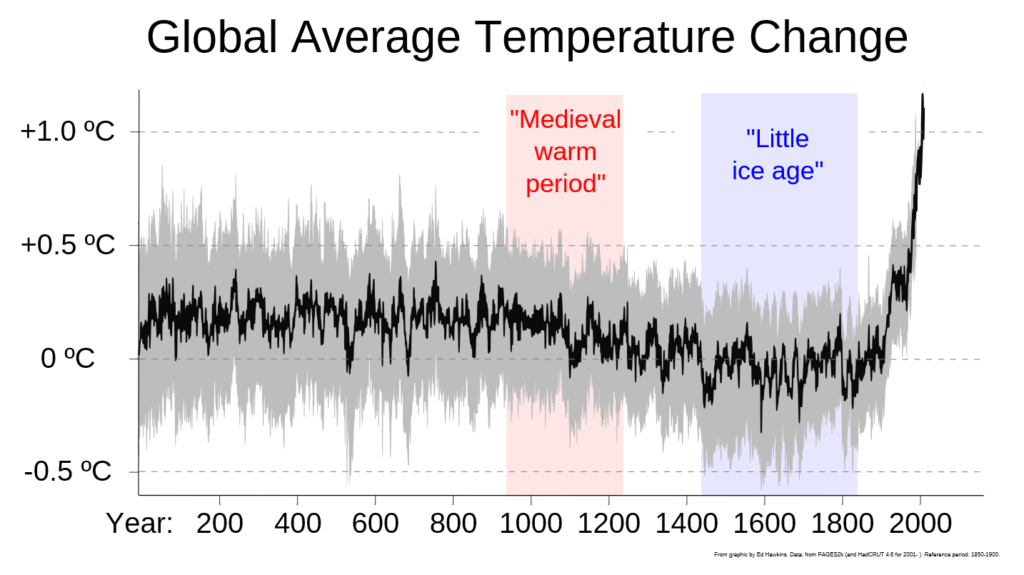
For some time, fossil-fuel sponsored skeptics argued even this simple fact. But yes, it’s clear now that – with the world’s five warmest years in human history all occurring since 2015 and with nine of the 10 warmest years occurring since 2005 – and with the temperature trend obvious over the past century- it is getting hotter. In fact, we WERE headed toward another one of those ice ages we get about every 90,000 years, but our carbon burning put a stop to that.[5]
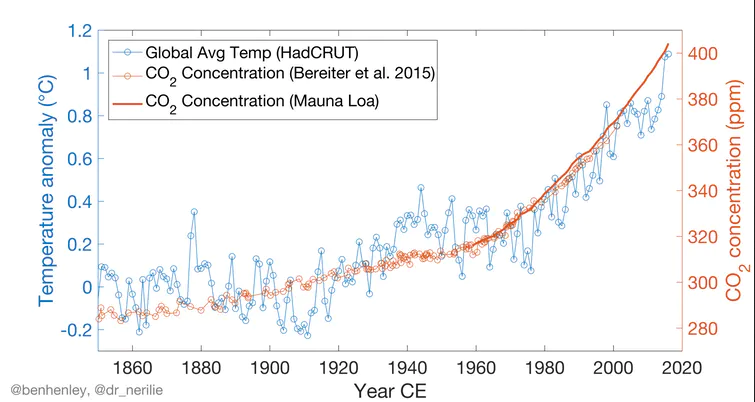
3. Adding Greenhouse Gasses Makes you hotter.
The Earth isn’t moving closer to the Sun, so what else could cause the temperature rise? Well, back at that campfire, putting on a down jacket and woolen hat makes you warmer, because it traps the warmer air from your body closer to your skin. And that’s what the Earth did – we gave it a warmer coat. Or put another way, we rolled up the car windows on a hot day.
Back in the 19th century, a Swedish scientist named Svante Arrhenius (who studied with Boltzmann and earned a Nobel Prize in 1903), developed a rule to explain how a doubling of Carbon Dioxide (CO2) would lead to an increase in earth’s surface temperature, as that “greenhouse gas” blocked emissions of heat back out into space[6]. As we know, on the moon, this is not an issue.[7] However, Earth’s atmosphere traps heat, and allows us to live. Note that it’s NOT the oxygen and nitrogen in air that traps the heat – it’s the small fraction of air that is greenhouse gases.
A woman – Eunice Newton Foote – first demonstrated that CO2 is a “greenhouse gas” back in 1856.[8] That same observation was also later made by a famous Irish scientist, John Tyndall, who experimentally demonstrated the “greenhouse effect” in 1859, and included the infrared radiation aspect that Foote had omitted.[9] This Greenhouse Effect is estimated at between 2 to 4.5ºF temperature increase in the short run, rising to 2.7° to 8.1° Fahrenheit over hundreds of years as the planet responds to increased CO2 in the atmosphere and reaches a new temperature equilibrium.[10]Just as your car doesn’t reach top speed the instant you step on the gas, Earth’s temperature doesn’t react instantly to each year’s new record-high carbon dioxide levels. Thanks to the high heat capacity of water and the huge volume of our global oceans, Earth’s surface temperature resists rapid changes, like the inertia of your car. One reason is: part of the excess CO2 and heat is absorbed by the ocean. This delayed reaction means rising greenhouse gas levels don’t immediately have their full impact on surface temperature. But the connection is clear as our “car” has gathered momentum since 1900.[11]
We humans did, by burning fossil fuels. Many of the great advances in human civilization in the past 200+ years have come from burning fossil fuels: the heat in your house, the gas in your car, the fuel in airplanes – all made possible because of the massive returns on investment from those fuels. Those fuels were immensely profitable and popular, starting at over 50:1 energy gained over energy invested (EROI) to produce, then declining to 30:1 EROI, and on down to about 10:1 today. But those fuels came with a Cost that is not reflected in their Price. The hidden Cost is that fossil fuels have dumped many pollutants into our air and water: soot, smog, lead and mercury in
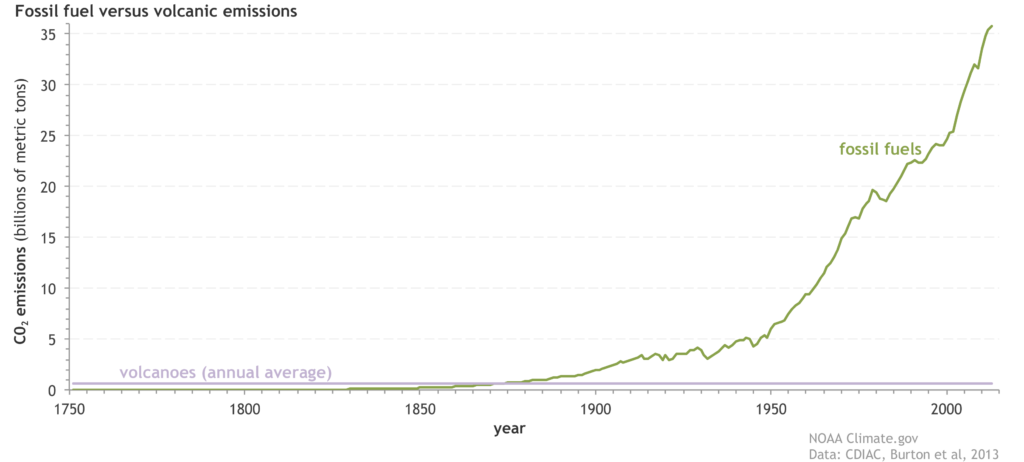
the water (and in your tuna fish[12]), acid in the rain and the ocean, but most importantly in volume and climate effect: Carbon Dioxide. Arrhenius talked about “evaporating our coal mines into the air”, and in fact we have put more than 2,000 billion tons of carbon dioxide into our air and oceans since the start of the Industrial Revolution. That’s CO2 that would NOT have been emitted without human activity. And our CO2 pollution dwarfs natural sources of CO2 like volcanoes, as shown on the chart at right.[13]
As shown in the chart below, CO2 has been controlling Earth’s temperature for a long time, and CO2 hasn’t been this high for at least 800,000 years; further, some studies say for millions of years.[14]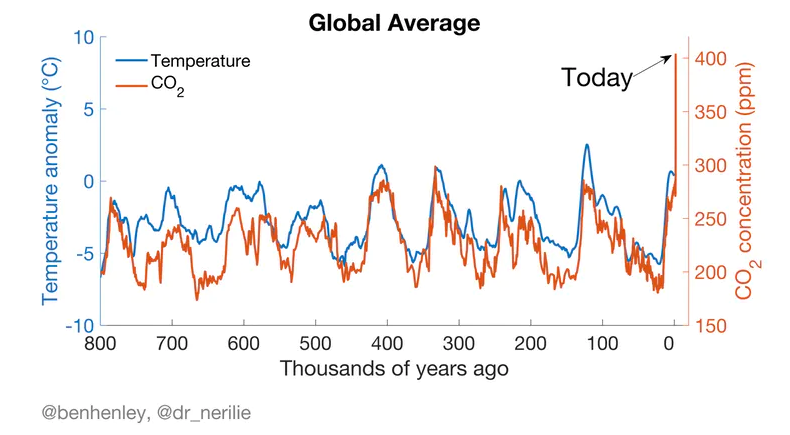 No other theory explains what triggered the rapid temperature rise we are experiencing: not solar activity, cosmic rays, volcanoes, water vapor, nor long term celestial factors, etc. If natural factors alone were at work, we’d be entering another ice age. In fact, the UPPER atmosphere IS COOLING, which tells us that the ever-thicker blanket of greenhouse gases down here is trapping enough heat to reverse the natural, very slow process of celestial climate change which could lead to the next Ice Age. There is much more to the story[15] of how earth’s climate changes over millions and billions of years – stories of asteroids, giant volcanoes, more flavors of greenhouse gases, countervailing climate forcings, and an earth moving gradually from snowball to swamp and back again. But the basics you needed to know about this Climate Crisis, you learned in grade school, and the science behind it has been proven since the 19th century.
No other theory explains what triggered the rapid temperature rise we are experiencing: not solar activity, cosmic rays, volcanoes, water vapor, nor long term celestial factors, etc. If natural factors alone were at work, we’d be entering another ice age. In fact, the UPPER atmosphere IS COOLING, which tells us that the ever-thicker blanket of greenhouse gases down here is trapping enough heat to reverse the natural, very slow process of celestial climate change which could lead to the next Ice Age. There is much more to the story[15] of how earth’s climate changes over millions and billions of years – stories of asteroids, giant volcanoes, more flavors of greenhouse gases, countervailing climate forcings, and an earth moving gradually from snowball to swamp and back again. But the basics you needed to know about this Climate Crisis, you learned in grade school, and the science behind it has been proven since the 19th century.
FOOTNOTES:
[1] CLOSE TO HEAT:
While near the campfire, you can also feel the difference in temperature between your side facing the fire – and your side facing away from the fire. Just as the Moon, without an atmosphere, varies from 260ºF to minus 280ºF – because it has no atmosphere to capture and spread the heat around as Earth does.
[2] HOW HOT SHOULD IT BE?
The theory of how hot a ‘black body’ should be while absorbing energy from an energy source at a certain distance was formulated in 1879 by Austrian physicist Josef Stefan. In 1884 Austrian physicist Ludwig Boltzmann developed the same theory by other means. Stefan’s insight was based on John Tyndall’s 1864 experiments. “The law was almost immediately experimentally verified. Heinrich Weber in 1888 pointed out deviations at higher temperatures, but perfect accuracy within measurement uncertainties was confirmed up to temperatures of 2217° F by 1897.”
[3] REFLECTING HEAT:
Called the ‘albedo’
al·be·do /al’bedo/
noun: Astronomy
noun: albedo; plural noun: albedos
Definition: the proportion of the incident light or radiation that is reflected by a surface, typically that of a planet or moon.
Example: “the lunar craters have a lower albedo than the surrounding terrain” (because of shadows)
[4] BIG DIFFERENCE:
The actual numbers are -1 ºF and 59ºF , but let’s not get picky. It’s still a 60ºF life-giving temperature difference.
[5] IT STARTED WITH COAL:
Notice in the diagram how the slow decrease in temperature since about 950AD started trending sharply upwards in the early 19th century, as the Industrial Revolution – driven by coal – ramped up.
[6] ATMOSPHERE IS KEY:
Beginning with work by Joseph Fourier in the 1820s, scientists had understood that gases in the atmosphere might trap the heat received from the Sun.
[7] IT’S THE CARBON DIOXIDE…
Arrhenius was the first person to predict that emissions of carbon dioxide from the burning of fossil fuels and other combustion processes were large enough to cause global warming. In his calculation Arrhenius included the feedback from changes in water vapor as well as latitudinal effects, but he omitted clouds, convection of heat upward in the atmosphere, and other essential factors. His work is currently seen less as an accurate quantification of global warming than as the first demonstration that increases in atmospheric CO2 will cause global warming, everything else being equal. His work was carried forward by E.O Hulburt, who calculated that doubling CO2 would create approximately a 4°C rise of surface temperature, and thus “the carbon dioxide theory of the ice ages… is a possible theory”. Hardly anyone noticed this paper. Hulburt was an obscure worker at the U.S. Naval Research Laboratory, and he published in a journal, the Physical Review, that few meteorologists read. The then-established consensus was stated in such authoritative works as the American Meteorological Society’s 1951 Compendium of Meteorology: the idea that adding CO2 would change the climate was never widely accepted and was abandoned – temporarily.
[8] A WOMAN LEADS:
Three years before Tyndall, an American painter and amateur scientist, Eunice Newton Foote, had already demonstrated that CO2 absorbs heat. She simply measured the temperatures of glass tubes exposed to sunlight, one filled with air and one with CO2. Foote went on to speculate that if there had been a period when the atmosphere held more of the gas, the planet would have been warmer. The scientific community ignored the brief note from an unknown female in a scientific backwater (i.e., America), and Foote has seldom been given credit for her discovery.
[9] BROADER PROOF OF GREENHOUSE EFFECT:
Tyndall was the first to correctly measure the relative infrared absorptive powers of the gases nitrogen, oxygen, water vapour, carbon dioxide, ozone, methane, and other trace gases and vapours. He concluded that water vapour is the strongest absorber of radiant heat in the atmosphere and is the principal gas controlling air temperature. Absorption by the other gases is not negligible but relatively small. Prior to Tyndall it was widely surmised that the Earth’s atmosphere warms the surface in what was later called a greenhouse effect, but he was the first to prove it.
[10] THE SKY’S THE LIMIT:
Of course, we’ll only reach a new temperature equilibrium if we STOP adding more CO2 than the planet can absorb naturally in plants and rock weathering – otherwise, Venus is the limit (864°F; read Jame’s Hansen’s book for if we pass the tipping point and reach the Venus Syndrome).
[11] GREENHOUSE MOMENTUM: https://www.climate.gov/news-features/climate-qa/if-carbon-dioxide-hits-new-high-every-year-why-isn%E2%80%99t-every-year-hotter-last
[12] MERCURY IN FISH:
A single serving of some types of tuna may surpass the maximum amount of mercury that you can safely consume per week. (click for details)
[13] HUMANS ARE 59 TIMES FASTER:
The speed at which CO2 is rising has no comparison in the recorded past. The fastest natural shifts out of ice ages saw CO2 levels increase by around 35 parts per million (ppm) in 1,000 years. It might be hard to believe, but humans have emitted the equivalent amount in just the last 17 years. [Source]
[14] JOINING THE DINOSAURS:
A. https://www.scientificamerican.com/article/earths-co2-could-spike-to-a-level-not-seen-since-the-dinosaurs/
B. https://archive.thinkprogress.org/carbon-dioxide-levels-sea-antarctica-b435497e1266/
C. https://www.nature.com/articles/ncomms14845
[15] WORSE IS YET TO COME:
For instance, things continue to get WORSE: https://news.un.org/en/story/2020/06/1065732
More From Gregg Dieguez ~ “InPerspective”
Mr. Dieguez is not a climate scientist, but he co-founded the award-winning Energy & Environment Program for the MIT Club of Northern California in 2003, reads a lot, and took the MIT Climate Science Course. He is also open to correction, because the Truth Is Out There.




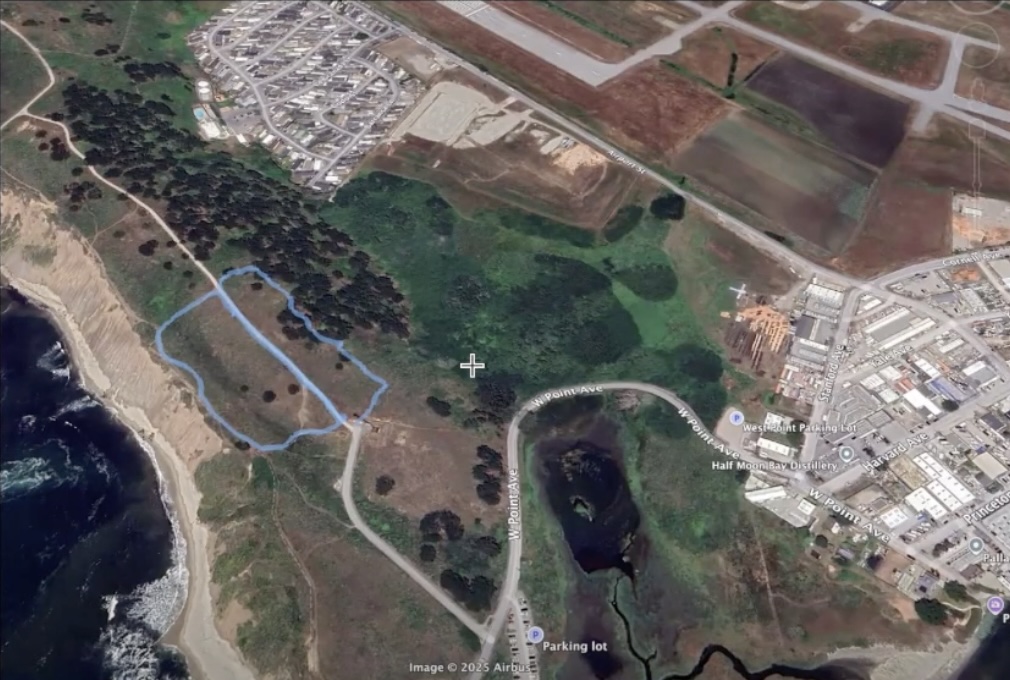


According the the definition in the peer-reviewed literature, I’m part of the “consensus on climate change.”
https://sealevel.info/consensus_defined5_1280x640.png
All you need to be part of the “97% consensus” is answer “risen” and “yes” to these two questions, respectively:
1. “When compared with pre-1800s levels, do you think that mean global temperatures have generally risen, fallen, or remained relatively constant?”
2. “Do you think human activity is a significant contributing factor in changing mean global temperatures?”
There’s consensus that Earth’s climate is warmer than during the 1700s (Little Ice Age). There’s also consensus human activity contributed to that warming. That’s all. There’s scant evidence, and certainly no consensus, that the warming is at all harmful,
In fact, scientists call warm periods, like the current warm period, “climate optimums.”
So, CO2 is not a pollutant.
I agree with the consensus: on average, the Earth is slightly warmer now than it was during the Little Ice Age, and human emissions of CO2 and other radiatively active gases contributed to that warming. However, climate activists call me a “climate denier” for acknowledging the compelling evidence that manmade climate change is modest and benign, and CO2 emissions are beneficial rather than harmful.
If you want to learn about climate change (or about any other highly politicized issue), it is essential that you get information from BOTH sides of the debate. So here is a list of high quality resources:
https://tinyurl.com/learnmore4
It has:
● accurate introductory climatology information
● in-depth science from BOTH skeptics & alarmists
● links to balanced debates between experts on BOTH sides
● information about climate impacts
● links to several of the best blogs on BOTH sides of the issue
BTW (and this is a nit), CDIAC’s data indicates that mankind has added less than 1700 ppmv of CO2 to the atmosphere, not 2000:
http://sealevel.info/global.1751_2014.ems5.html
https://sealevel.info/madras_famine_with_co2_300_vs_glut_with_co2_400_horizontal2_and_SciAm1920_potatoes_1740x1129.png
https://sealevel.info/Famine-death-rate-since-1860s-revised-annot1_1908x954b.jpg
Glad you write that you are open to correction. Have you read Mike Shellenberger’s new book “I Apologize for the Climate Scare.”? What do you think?
I read his book promo site here: https://environmentalprogress.org/big-news/2020/6/29/on-behalf-of-environmentalists-i-apologize-for-the-climate-scare
And I replied there, and here’s a copy:
——————————————————————————————-
As usual, a mixture of truth and lies with the intent to deceive. The first thing I look for is the credibility of the author. None.
The second thing is, like, Footnotes. To like, peer-reviewed studies. None.
Here are a few of the distracting semi-lies:
1. “Carbon emissions are declining in most rich nations and have been declining in Britain, Germany, and France since the mid-1970s ”
Well, so what? Emissions overall are increasing because like: China and India and Africa. So this point is irrelevant. The higher measurement of greenhouse gases in the air and acid in the ocean is incontrovertible.
2. “Climate change is not making natural disasters worse”
Tell him to talk to Kerry Emmanuel and the MIT scientists who say otherwise.
3. “Humans are not causing a “sixth mass extinction” Have him read “the Sixth Extinction”, note the extinction rate at 1,000 to 10,000 times the normal background rate, and publish peer-reviewed truth.
The problem is the Fossil Fuel industry has actively brainwashed people for decades and continues to fund lies and propaganda – read Merchants of Doubt. It has hundreds of footnotes to proof.
The guy seems to be selling his book. And he doesn’t seem to mind killing off grandchildren to do it.
Now, there IS A CASE that many environmental regulations are needlessly expensive, and could better be served by a Carbon Tax. Read Chris Knittel of MIT for that. But the need to stop and undo our pollution? That is obvious to anyone with a brain. You know, those people wearing masks these days.